-
what a season for hopper bird feeders!
Busy feeders this season… that would be an understatement! Oh how I wish we were in the birdseed business because it’s been an amazingly active season for seed feeders.
Now there’s a pretty good smorgasbord going on in our yard, with suet, peanuts, mealworms, even the squirrels get theirs as all bird feeders have baffles to keep them at bay. But sunflower hearts, cardinal and finch mix? Omg… going through this seed like water, and spending more on seed than groceries!
Winter’s been a bit longer and colder than last year, but this is supposed to be spring right? Wrong – central IL just saw 5 inches of the white stuff today. Bluebirds who have started laying eggs will loose the clutch if incubation has not yet begun.
Large Hopper Bird Feeders are being filled at the rate of ridiculousness, and positively, squirrels aren’t raiding them! Big double hoppers like this are being emptied twice a week, we’ve never seen birds so ravenous. Raging hormones and gearing up for nesting couldn’t possibly be the cause? More birds? Maybe they’ve told all their friends of a great new restaurant? But it’s not just our yard, reports from our local feed store say it’s been a fantastic seed-selling season, more so than any other they can recall.
This kind of seed’s not cheap either. Past droughts and fuel costs have caused most birdseed to skyrocket in cost. While searching Craigslist recently a person was bartering with food stamps. Hmmm… wonder if anyone would take food stamps as payment for bird seed?
The good news is migratory birds are on their way, nectar costs just pennies to make (so easy too), and well, fruit and jelly are nothing compared to the money being spent on on seed 🙂
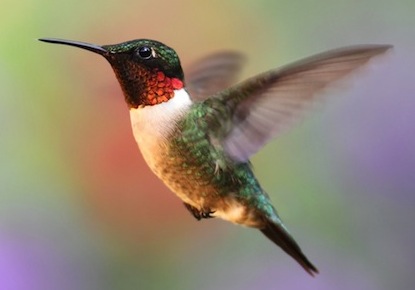
-
a swell idea for window bird feeders
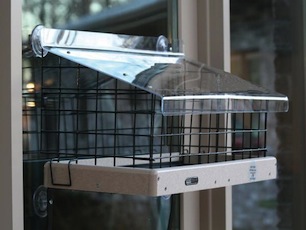 When one’s feeding backyard birds, the objective is usually to see those birds! If you’re getting on up there in years, and your eyesight’s not so great (like me)… keeping a pair of binoculars near the main watching window is always convenient.
When one’s feeding backyard birds, the objective is usually to see those birds! If you’re getting on up there in years, and your eyesight’s not so great (like me)… keeping a pair of binoculars near the main watching window is always convenient.Squirrels, blasted squirrels always seem to find and conquer anything that doesn’t have a baffle on it. One lousy window bird feeder (that’s actually mounted on the deck rail) for seeing birds close-up, always seems to have a squirrel in it! Little pigs are even fed, and have their own feeders with which to contend, but alas… it’s never enough.
 Well, this new handy dandy window feeder just might do the trick! With an innovative cage for keeping squirrels out, the birds may just be able to eat in peace… where I can actually see them sans the binoculars. Can’t wait to fill ‘er up and try this one on for size!
Well, this new handy dandy window feeder just might do the trick! With an innovative cage for keeping squirrels out, the birds may just be able to eat in peace… where I can actually see them sans the binoculars. Can’t wait to fill ‘er up and try this one on for size! -
new experience with thistle feeders
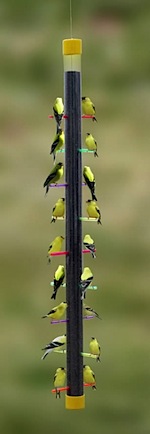 “We are just learning about the appetites of the finches.
“We are just learning about the appetites of the finches.
We are already out of thistle !!! But what fun !! Jan”Recently some folks in Alexandria, LA developed an interest in backyard birding. Diving right in with a suet feeder, hopper style feeder for sunflower seed, a bird bath with mister (for summer) and two thistle feeders, the timing couldn’t have been better – for the birds and for them to witness the amazing flurry of activity this pre-spring season.
By her note above, we’re gathering they’ve got flocks of pine siskins and goldfinches in the yard right now, we sure do here in North GA.! For months thistle feeders sat, with seed going bad due to lack of activity. Then out of nowhere… tons of birds chowing down on thistle!
Also called Nyjer, thistle’s other nickname among many is “black gold” because it’s not a cheap seed to offer. A bit on the pricey side, it does have the benefit of being a non-germinating seed, one of very few seeds that won’t sprout weeds. But it’s about the only food adults will feed chicks in summer, so extra feeders (like thistle socks) and lots of seed greatly helps goldfinches thrive and flourish during their late breeding season (June and July).
Being new to the birding scene, Jan had the right idea in mind when she inquired about creating a welcoming and bird-friendly habitat in their yard. No single feeder, house, or birdbath will attract as many song birds as an overall habitat with natural food sources and shelter. And since we’re in the same planting zone, it was fairly easy to come up with a few suggestions too. Rather than re-word, and re-type the email, here’s our thoughts on cre
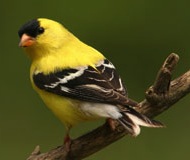 ating an attractive and wildlife-friendly environment.
ating an attractive and wildlife-friendly environment.“OK, did some research and thinking of my own yard… here are some suggestions:
Overall: Mature trees and Shrubs are very good for attracting all winged friends as not only a food source, but shelter. Since this is an open area, I’m thinking your yard must have mature trees along the back/sides? Many birds nest in trees and shrubs as they’re not all considered “cavity-dwellers” (birdhouse users).
If you’d like some kind of height or focal point around the new area, Butterfly Bush, Viburnum, Mimosa, or a Crab Apple is a great choice. These are hearty, and provide both shelter and food (nectar or fruit). Any of the native berry-producing shrubs will also provide a great food source.
Using pots for annuals is always a great option too, for color, nectar and seeds in fall!
Petunias, Zinnias, and various salvias; most garden center plants now have tags depicting if the plants provide a food source, so just look around. There should be lots of options here! You can even save seeds in the fall for replanting in spring.Cardinals, chick
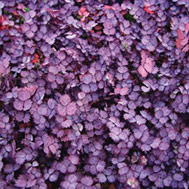 adees, finches and titmice will eat seeds of many plants. The trick is not to dead-head them in fall when the urge strikes! There are lots of perennials that fit the bill in this category: coneflower, coreopsis, seedum, black-eyed susan, goldenrod, sunflowers, mexican sunflower, native salvia-(very good), coral bells,. Again look around at the garden center, and if you’re lucky… you’ll find an employee with some knowledge on the subject!
adees, finches and titmice will eat seeds of many plants. The trick is not to dead-head them in fall when the urge strikes! There are lots of perennials that fit the bill in this category: coneflower, coreopsis, seedum, black-eyed susan, goldenrod, sunflowers, mexican sunflower, native salvia-(very good), coral bells,. Again look around at the garden center, and if you’re lucky… you’ll find an employee with some knowledge on the subject!As far as for ground cover: I think mulching the area and adding plants is a better option than a solid ground cover. You’ll want to be able to get to the feeders, bath, mister and “parts” of the landscape without stepping all over things. Also, spilled seed may sprout weeds, and it’s easier to control that if not covered solid with growth.
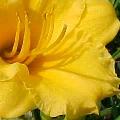 Day lilies are a good choice, the Stella de Oro’s are quite hearty and pretty! If you wanted something more low-growing that spreads, (full sun) try purple sheep’s burr, also called purple goose leaf. In fact this would be a beautiful contrast with yellow lilies! The Stella variety tends to stay more compact as opposed to some which grow taller and appear “lanky”. Never, ever plant creeping strawberry, or ivy…these are the bane of my existence in parts of my yard 🙁 They are also a wonderful habitat for snakes, especially if you’ll have the mister going when it’s warm!
Day lilies are a good choice, the Stella de Oro’s are quite hearty and pretty! If you wanted something more low-growing that spreads, (full sun) try purple sheep’s burr, also called purple goose leaf. In fact this would be a beautiful contrast with yellow lilies! The Stella variety tends to stay more compact as opposed to some which grow taller and appear “lanky”. Never, ever plant creeping strawberry, or ivy…these are the bane of my existence in parts of my yard 🙁 They are also a wonderful habitat for snakes, especially if you’ll have the mister going when it’s warm!Native salvia: I’ve got a bed of this which provides color from spring through fall. Vibrant red, there are always
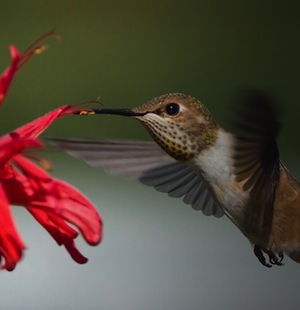 hummingbirds and butterflies hovering. It’s actually below one of the misters, and does well with the “extra water”. Extremely hearty, it multiplies each year, spreading roots, but does tend to grow taller, more of a back-drop. Lantana would also be a good choice if you’ve got the space for it to grow. I love perennials!
hummingbirds and butterflies hovering. It’s actually below one of the misters, and does well with the “extra water”. Extremely hearty, it multiplies each year, spreading roots, but does tend to grow taller, more of a back-drop. Lantana would also be a good choice if you’ve got the space for it to grow. I love perennials!It may be helpful to actually sketch out the area on paper before planting. Drop in the plant names to get an idea. You can always do search for pics to get an idea too!
Okay… hope this helps, and as always, feel free to ping me back with questions”
